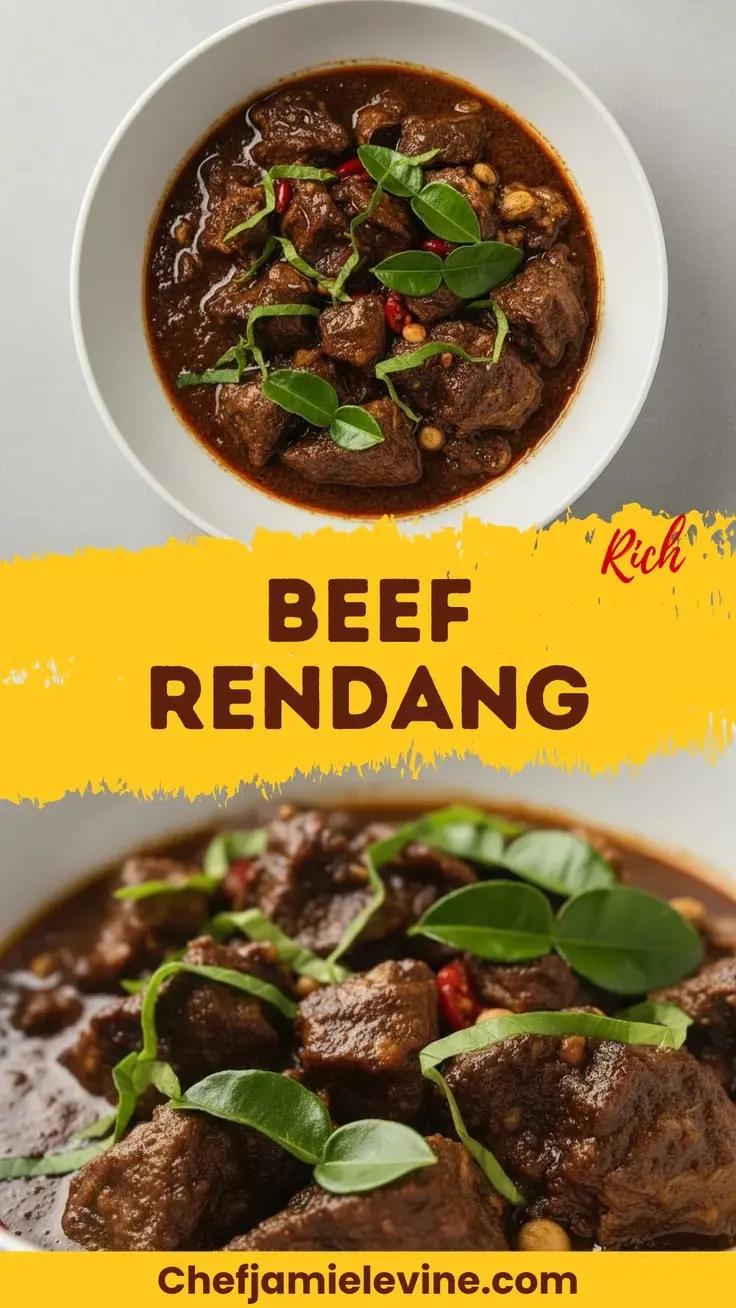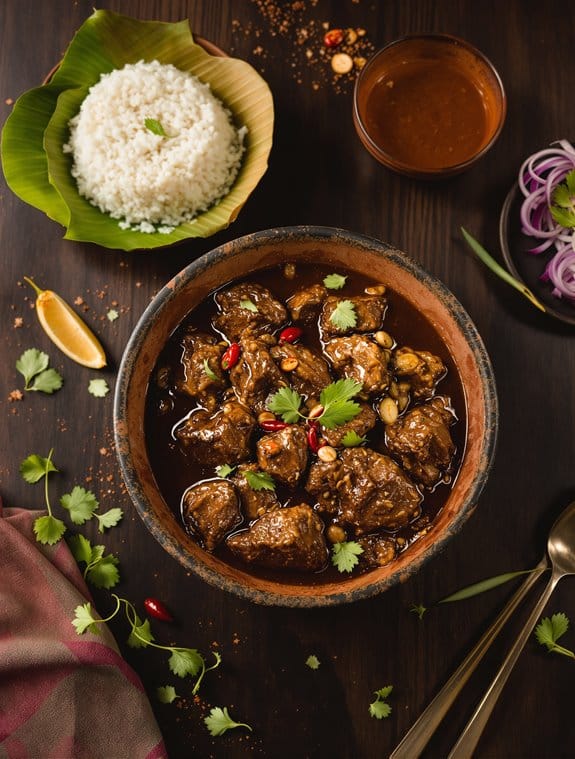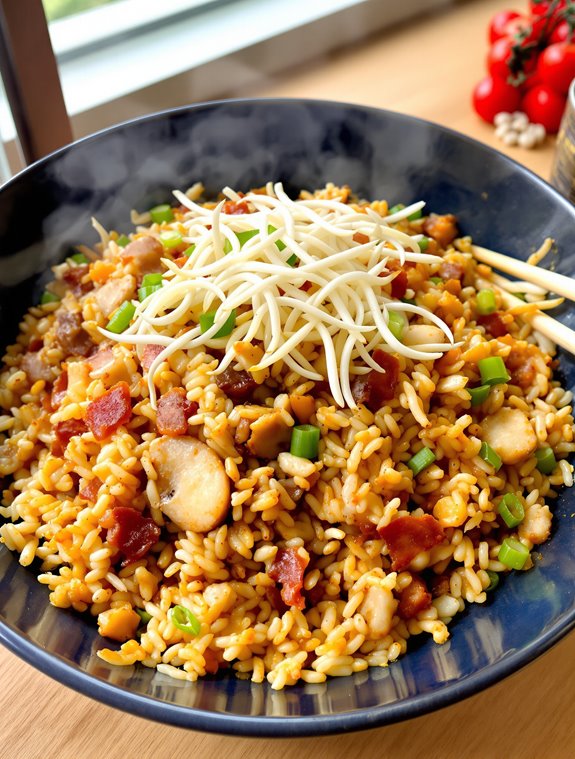Why You’ll Love this Authentic Beef Rendang
Every home cook should experience the joy of making authentic Beef Rendang at least once.
There’s something magical about watching this Indonesian classic transform from raw ingredients to a rich, deeply flavored curry that practically melts in your mouth.
I love how the fragrant spices—coriander, turmeric, cumin—mingle with coconut cream to create that signature thick sauce.
And the beef? After simmering for hours, it becomes tender enough to pull apart with a fork.
Can you imagine the aroma that fills your kitchen? Trust me, your family will hover nearby, wondering when dinner’s ready.
What Ingredients are in Authentic Beef Rendang?
To create a truly authentic beef rendang, you’ll need a combination of tender meat, fragrant spices, and rich coconut cream. The magic of this Indonesian classic comes from the balance of heat, aromatics, and slow cooking that transforms these simple ingredients into something extraordinary.
I always recommend gathering everything before you start, as the process flows much more smoothly when you’re organized.
- 1½ kg beef chuck steaks, cut into 3cm pieces
- 1 stem fresh lemongrass, chopped
- 2 small fresh red chilies, chopped
- 2 medium onions (one chopped, one thickly sliced)
- 3 cloves garlic, chopped
- 1 tablespoon chopped fresh ginger
- 1 tablespoon vegetable oil
- 3 teaspoons ground coriander
- 1 teaspoon ground turmeric
- 2 teaspoons ground cumin
- 1 cinnamon stick
- 8 fresh curry leaves
- 2 teaspoons brown sugar
- 1 (425 ml) can coconut cream
- 1 tablespoon lemon juice
If you can’t find fresh curry leaves in your local supermarket, try an Asian grocery store where they’re more commonly available.
The coconut cream (not milk) gives rendang its signature rich texture, so I wouldn’t substitute it if possible. For the beef, chuck steak works perfectly because it becomes wonderfully tender after the long cooking process, but you could also use brisket or shin if that’s what you have on hand.
How to Make this Authentic Beef Rendang

To start your beef rendang journey, you’ll first need to prepare your aromatics. Take 1 stem of fresh lemongrass, 2 small red chilies, 1 medium onion, 3 cloves of garlic, and 1 tablespoon of fresh ginger—all chopped—and process them together until smooth. This fragrant paste is the flavor foundation of your rendang, containing all those wonderful aromatics that will infuse into the meat during cooking. I like to use a food processor for this step, but a blender works just as well if that’s what you have on hand.
Next, heat 1 tablespoon of vegetable oil in a large, heavy-bottomed pan and add your extra thickly sliced onion along with 3 teaspoons of ground coriander, 1 teaspoon of ground turmeric, and 2 teaspoons of ground cumin. Cook this mixture, stirring frequently, until the onion softens and the spices become fragrant—about 3-4 minutes. This blooming of the spices in oil is essential for developing depth of flavor.
Add your lemongrass paste and continue cooking until the raw smell disappears and your kitchen is filled with the most incredible aroma. Now, stir in your 1½ kg of beef chuck pieces, 1 cinnamon stick, 8 torn curry leaves, 2 teaspoons of brown sugar, and 425ml can of coconut cream. Bring this mixture to a gentle simmer, cover, and let it cook for an hour.
The magic of rendang happens in the final stage. After the initial covered simmer, remove the lid and continue cooking for another 1½ hours, stirring occasionally to prevent sticking. During this time, the liquid will gradually reduce, and the coconut cream will caramelize around the meat, creating that distinctive dark, rich sauce that clings to each piece of beef. The meat should be fork-tender and practically melting by the end of cooking.
Just before serving, discard the cinnamon stick and stir in 1 tablespoon of lemon juice to brighten all those deep flavors. Remember, authentic rendang actually tastes better the next day when all those complex flavors have had time to meld, so don’t hesitate to make it ahead of time.
Authentic Beef Rendang Substitutions and Variations
While authentic beef rendang follows traditional Indonesian preparation methods, I’ve found several ways to adapt this recipe based on your pantry or dietary needs.
Can’t find fresh lemongrass? Use dried instead, about 1 tablespoon. For a milder version, reduce the chilies or substitute with bell peppers.
Vegetarians might try firm tofu or tempeh, though the cooking time drops considerably. No curry leaves? Bay leaves work in a pinch, though the flavor profile shifts slightly.
My favorite variation? Adding star anise for complexity, or a splash of tamarind paste for tanginess.
Coconut milk can replace cream for a lighter texture. Whatever you try, maintain that slow-cooking method—it’s non-negotiable.
What to Serve with Authentic Beef Rendang
Pairing the right sides with authentic beef rendang elevates this already extraordinary dish to new heights.
I always serve mine with steamed jasmine rice to soak up that rich, complex sauce – honestly, it would be criminal to waste a drop.
Coconut rice makes an even more indulgent option when I’m feeling fancy.
For vegetables, I like cucumber slices for coolness and crunch against the warm spices.
A simple side of stir-fried morning glory or water spinach adds color and nutrition.
Want something pickled? Try acar – Indonesian pickled vegetables that cut through the rendang’s richness perfectly.
Final Thoughts
Beyond these perfect side pairings, I’ve discovered that beef rendang offers something truly special in the world of home cooking.
The dish transforms completely as it simmers—from a soupy curry to a rich, caramelized masterpiece that only gets better with time.
I still remember my first attempt, nervously watching that coconut milk reduce, wondering if I’d ruined it.
Now, it’s my go-to for impressing dinner guests.
The beauty of rendang is its forgiving nature; your patience is rewarded with deep, complex flavors that tell a story of time and care.

Beef Rendang
Ingredients
Equipment
Method
- In a food processor or blender, combine the chopped lemongrass, red chilies, one chopped onion, garlic, and fresh ginger. Process until you have a smooth aromatic paste.
- Heat the vegetable oil in a large, heavy-bottomed pan. Add the thickly sliced onion, ground coriander, ground turmeric, and ground cumin. Cook for 3-4 minutes, stirring frequently, until the onion softens and spices become fragrant.
- Add the lemongrass paste to the pan and continue cooking until the raw smell disappears, about 2-3 minutes.
- Stir in the beef chuck pieces, cinnamon stick, curry leaves, brown sugar, and coconut cream. Bring the mixture to a gentle simmer.
- Cover the pan and let it cook for 1 hour on low heat.
- Remove the lid and continue cooking for another 1½ hours, stirring occasionally to prevent sticking. The liquid will gradually reduce, and the coconut cream will caramelize around the meat, creating a rich, dark sauce.
- When the beef is fork-tender and the sauce has thickened to a rich coating, remove the cinnamon stick and stir in the lemon juice.
- Let the rendang rest for 5-10 minutes before serving to allow the flavors to settle.



